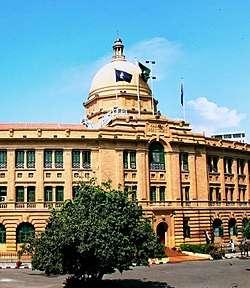George Wittet
George Wittet (1878-1926) was a Scottish architect who worked mostly in Bombay (now Mumbai), India.
George Wittet | |
|---|---|
| Born | 1878 |
| Died | 1926 (aged 47–48) |
| Occupation | Architect |
| Buildings |
|
Biography

George Wittet was born in Blair Atholl, Scotland in 1878. He studied architecture with a Mr. Heiton of Perth, Scotland, and worked in Edinburgh and York before moving to India.
Wittet arrived in India in 1904 and became an assistant to John Begg, then Consulting Architect to Bombay. The two men were responsible for the evolution and subsequent popularity of the Indo-Saracenic Style of architecture.
On 12 May 1917, Wittet, by then Consulting Architect to the Government of Bombay, was unanimously elected as the first President of The Indian Institute of Architects.[1]
Wittet designed some of Bombay's best known landmarks: the Prince of Wales Museum, the Gateway of India, the Institute of Science, the Small Causes Court at Dhobitalao, the Wadia Maternity Hospital, Bombay House, the King Edward Memorial Hospital, the Grand Hotel and other buildings at the Ballard Estate, by the Bombay Docks.
In Karachi, he designed the Karachi Port Trust (KPT) building.[2]
With John Begg he developed and popularised the Indo-Saracenic style in architecture.[3]
He died of acute dysentery in Bombay in 1926, and is buried in the Sewri cemetery.
References
- "Presidents". Indian Institute of Architects. Archived from the original on 30 July 2012. Retrieved 16 August 2012.
- History KPT official website Retrieved 5 August 2013
- "George Wittet". The Mumbai Pages. Retrieved 16 August 2012.